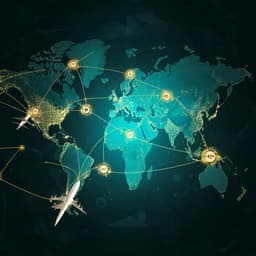
Business
COVID-19 impact and survival strategy in business tourism market: the example of the UAE MICE industry
A. A. Aburumman
This study conducted by Asad A. Aburumman explores the profound impact of COVID-19 on the global and UAE MICE markets. It highlights drastic demand reductions due to travel restrictions and presents innovative survival strategies through a 5P marketing approach and outsourcing methods.
~3 min • Beginner • English
Introduction
The paper situates the MICE (meetings, incentives, conferences and events) industry as a key driver of tourism-led economic diversification in the UAE, noting that tourism contributed 11.5% to UAE GDP in 2019 and that Dubai was a global leader in business tourism prior to COVID-19. The pandemic and associated non-pharmaceutical interventions (lockdowns, travel bans, restrictions on gatherings) abruptly halted international travel and events from March 2020, severely impacting MICE globally and in the UAE. Given uncertainty around the pandemic trajectory and limited available statistics early in 2020, the study seeks to fill a gap in understanding COVID-19’s global and local impact on the MICE industry and to determine survival strategies for MICE firms in the UAE. The stated aim is to investigate COVID-19’s impact on global and UAE MICE markets and to identify a competitive survival strategy for tourism companies. The study’s tasks include: assessing the pandemic’s effect on global tourism and the UAE MICE sector; selecting economic efficiency indicators to compute MICE company profitability in the UAE; and proposing a survival strategy centered on outsourcing within a globalized, COVID-affected economy.
Literature Review
The review highlights business tourism’s prominence in major centers like Abu Dhabi and Dubai, where conferences, congresses, and diplomatic visits drive demand. It outlines commonly recognized principles in tourism infrastructure and management (product typologies and territoriality; presence of private/public agencies; resource and flow management; client choice). Outsourcing is identified as a means to scale, solve operational problems, and manage crises like COVID-19. Competitiveness in MICE is framed as creating sustainable advantages (innovation, quality, organizational culture, reputation, consumer behavior management). Prior research emphasizes infrastructure and support services, environmental sustainability, and tourist behavior as competitiveness determinants. Methods used in the literature include expert surveys, mixed methods, and various competitiveness indices (e.g., WEF Travel & Tourism Competitiveness Index) and models (Porter, Poon, WES, Dwyer, Crouch-Ritchie). Studies also apply multicriteria methods (PROMETHEE/GAIA) and structural models to link recovery and growth with sustainability. Comparative analyses (e.g., Slovenia vs. Serbia) identify gaps and needed innovations in MICE offerings. The review motivates focusing on outsourcing, innovation, service quality, and customer loyalty as levers for post-pandemic competitiveness.
Methodology
The study employs quantitative and qualitative analyses of secondary data to assess COVID-19’s impacts on global tourism and the UAE MICE market. Indicators analyzed include: world and UAE GDP growth rates (2019–2021); international tourist arrivals (global and by country, 2019–2020 and 2000–2020); international tourism receipts (2000–2020); employment loss and economic losses in travel, tourism, and aviation (2020); and scheduled departure flights (global and by country, Jan–Dec 2019; Jan–Jul 2020). Data sources comprise prior studies; World Bank; UNWTO; WTTC; OAG aviation analytics; Dubai Corporation/Department of Tourism and Commerce Marketing; Dubai World Trade Centre; Statista; UAE-Consulting; Oxford Analytica. To evaluate MICE company profitability, the study adapts the DuPont System of Analysis by integrating gross profit from sales, using the multiplicative relation: PMICE = NP/IS = NI/IC × GP/NI × NP/GP, where PMICE is MICE company profitability. A statistical approach is applied to model competitiveness and consumer behavior for forecasting, using a production function that relates the number of service offers to employment and outsourcing spending. Due to limited reliable post-pandemic data, some pre-pandemic figures are used as proxies pending availability of actuals.
Key Findings
- As of May 2020, 100% of destinations worldwide had COVID-19-related travel restrictions; tourism sectors across airlines, hospitality, attractions, and intermediaries were severely affected, with disproportionate impacts on SMEs and vulnerable groups.
- Macroeconomic outlook: World GDP expected to decline by 5.21% in 2020 (from +2.38% in 2019) and grow by 4.16% in 2021; UAE GDP projected at −4.5% in 2020 (from +1.7% in 2019) and +1.4% in 2021 (World Bank).
- Travel and tourism contributed 10.3% of global GDP (USD 8.9 trillion) and 330 million jobs in 2019; for 2020, WTTC projected losses of 121 million jobs and USD 3,435 billion in global GDP linked to the sector.
- International tourist arrivals fell 44% globally during Jan–Apr 2020 vs. 2019, with largest declines in Asia-Pacific (−51%), Europe (−44%), Middle East (−40%), Americas (−36%), and Africa (−35%). UNWTO scenarios indicated a potential 58–78% decrease in total 2020 international arrivals; worst-case estimates suggest a 1.140 billion drop in arrivals and a USD 1.170 trillion decline in international tourism receipts in 2020.
- Aviation impacts: Preliminary estimates indicated potential global GDP reductions up to 1.41–1.67% and 25–30 million job losses under worst-case scenarios. Scheduled departure flights declined from 3.234 million (Jan 2020) to 0.429 million (July 13, 2020). Largest absolute reductions were in the USA (−756k), China (−363k), and India (−112k); the UAE saw −21k flights over the same period.
- Relative declines in scheduled flights peaked globally at −69% in May 2020. The UAE’s most substantial relative drop occurred on June 1, 2020 (−82% vs. same period in 2019). Some recovery in scheduled flights was observed from June to mid-July 2020.
- Model-based profitability and competitiveness insights (pre-pandemic data): Long-term profitability could be stable post-pandemic, though returns on investment may decrease with introduction of new services; competitiveness shows limited direct linkage to profitability ratio. Estimated production function: Np = 6.927 Sp^0.287 Pp^0.128 i^0.284 (F=29.01; R^2=0.97; relative approximation error=0.14). Elasticities indicate low efficiency with respect to profits and employees (0.287 and 0.128). Forecasts (based on pre-pandemic data) suggest MICE service sales could rise by 61.6% over 2020–2023, with an average annual increase around 25%. Under ideal conditions, a minimum rate of return of at least 12.9% and a value-added tax not exceeding 38.9% are indicated to maintain service volumes.
- Strategic recommendation: Adoption of the 5P marketing mix (Product, Price, Place, Promotion, People) alongside outsourcing as an optimal survival and recovery strategy for MICE companies, emphasizing cost reduction, service quality, innovation, digitalization, and customer loyalty.
Discussion
The findings confirm that COVID-19 precipitated an unprecedented demand shock in global tourism and the UAE’s MICE sector, evidenced by steep declines in international arrivals and flight schedules. This directly addresses the research question by quantifying impacts and contextualizing the UAE’s exposure as a global MICE hub. The modeling indicates that while profitability can be stabilized, traditional levers (e.g., increasing staff or profit reinvestment alone) have low elasticity in boosting service offerings post-pandemic, pointing to the need for strategic shifts rather than scale alone. The proposed survival strategy—integrating outsourcing with the 5P marketing mix—links the empirical impact assessment to actionable recovery pathways: outsourcing to reduce operating costs and increase flexibility; and 5P-driven initiatives to refine product offerings (venues and hybrid events), adjust pricing, strengthen distribution (digital platforms), intensify promotion (targeted business events, PR), and leverage people (loyal/VIP customers and trained staff). Emphasizing innovation, service quality control, robust organizational culture, brand reputation, and consumer behavior management aligns with identified competitiveness determinants and current health and safety expectations, thereby enhancing resilience and competitive positioning in the post-pandemic MICE market.
Conclusion
The study demonstrates that COVID-19 severely disrupted global tourism and the UAE’s MICE industry, with sharp contractions in arrivals and air travel and substantial projected losses in GDP and employment. For the UAE, scheduled flights fell most markedly by 82% on June 1, 2020, reflecting deep demand reductions. Multiplicative analysis and a production-function approach suggest that maintaining profitability and competitiveness post-pandemic requires strategic adaptation more than scale expansion. The paper identifies outsourcing coupled with the 5P marketing mix as an optimal survival and recovery strategy for MICE firms, leveraging cost efficiencies, innovation, service quality, digitalization, and customer loyalty. These insights can guide MICE businesses and researchers in designing data-informed recovery and competitiveness strategies. Future research should validate and refine these models using reliable post-pandemic data and tailor strategies to evolving market conditions and health protocols.
Limitations
The analysis was constrained by the lack of reliable post-pandemic data during the study period; consequently, some calculations and forecasts rely on pre-pandemic figures. As actual post-pandemic data become available, more precise assessments can be made and the theoretical models and forecasts can be empirically verified. The generalizability of specific quantitative forecasts may be limited until such validation occurs.
Related Publications
Explore these studies to deepen your understanding of the subject.







